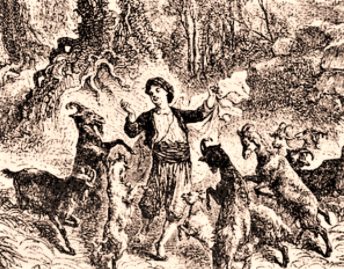The History of Coffee
- Home
- Blog
- The History of Coffee
An Ethiopian Legend
Estimated Reading Time: 7 minutes
Coffee beans grown around the world has its roots back to the coffee forests of the past in the Ethiopian plateau. According to legend, that the goat herder Kaldi first discovered the benefits of these famous coffee beans.
The legend goes that Kaldi discovered coffee beans when he observed that after consuming the berries from the same plant, the goats were so active that they didn’t want to go to bed at night.
When word spread to the east, and coffee beans made its way to the Arabian Peninsula and began its trip that would transport these Coffee beans all over the world

- Kaldi and the Dancing Goats
According to legend, Kaldi, also known as Khalid, is an Ethiopian goat herder who discovered the coffee beans plant in the year 850 AD, after which it was introduced to the Islamic world, and then to the rest of the world.

The legend of Kaldi the Ethiopian goatherd and dancing goats, which is the most commonly found coffee origin tale in Western literature, adds to the fabled belief that the Sufi experience with coffee beans occurred in Ethiopia, which is located across the narrow sea that separates the Red Sea from Arabia’s western coast.
- The Story
Kaldi observed that, when his goats were gnawing on those bright, red fruits from a particular bush, they got more active (jumping or dancing goats) and ate the fruit by himself. His excitement led him to take the fruits in the direction of the attention of an Islamic monastery monk at a close Sufi monastic center (zawiyah), but the Sufi monk was not happy with the use of the berries and tossed them into the flame, out of which the scent of a heavenly aroma sprang up. The beans that were roasted were swiftly taken off the fire then ground and dissolving in boiling water, resulting in the initial cup of coffee.
- The Arabian Peninsula
The cultivation of coffee beans and the trade in it began in the Arabian Peninsula. Coffee was first grown in the Yemeni province of Arabia in the 15th century, and by the 16th century, it had spread to Persia, Egypt, Syria, and Turkey.
Coffee wasn’t just enjoyed at home however; it was also enjoyed in the many coffee houses that were open to the public, they were known as the qahveh khaneh that started to pop up in cities throughout in the Near East. The popularity of cafes was unparalleled and the people who frequented them were involved in any kind of social event.

In addition to being able to enjoy these coffee beans and talk as well, but they also enjoyed performances, listened to music playing chess, and were up to date with the latest news. Coffee houses quickly became such an essential site for information sharing that they were often referred to as “Schools of the Wise.”
With thousands of pilgrims coming to Mecca, the city that is holy to all Muslims Mecca every year from across the globe the knowledge of this “wine from Araby” was beginning to become widely known.
- Coffee Comes to Europe
European travelers traveling to Near East brought back stories of an odd dark, black drink. The 17th century was the time when coffee was making its way into Europe and was becoming a popular drink throughout the continent.
A few people responded to the new drink with fear or suspicion and called coffee a “bitter creation of Satan.” A local church slammed coffee when it arrived in Venice in 1615. The issue was so heated that the Pope Clement VIII was asked to intervene. He decided to test the drink for himself prior to making a decision. He found the drink to be so enjoyable that he granted the papal blessing.
Despite this the coffee houses quickly becoming hubs for socializing and interaction in the main towns of England, Austria, France, Germany and Holland. Then in England “penny university”
began to pop up, so they were named for the fact that for the price of one penny, you could buy a cup coffee and have a stimulating conversation.
Coffee was able to replace popular breakfast beverages of the day alcohol and wine. People who consumed coffee instead of alcohol started the day feeling energized and alert in a way, and the performance of their jobs was significantly enhanced. (We prefer to consider this as a prelude to the current office coffee service.)
In the 17th century, there was nearly 300 coffee shops in London and many of them attracted similar patrons, which included brokers, shippers, merchants and even artists.
Many companies grew out of these specialty coffee houses. Lloyds of London, for instance, was founded within the Edward Lloyd’s Coffee House.
- The New World
In the mid 1600’s the coffee industry was introduced in the early 1600’s to New Amsterdam, later called New York by the British.
Coffee houses quickly appeared and tea was the most popular beverage across the New World until 1773, when colonists rebelled against a hefty tax on tea, imposed by the King George III. The uprising, dubbed “the” Boston Tea Party, would forever alter the American consumption habits towards coffee.
- Plantations Around the World
As the demand for the drink was growing There was intense competition for coffee beans to be grown out of Arabia.
The Dutch finally received seedlings in the second half of the 17th century. The earliest attempts to plant seeds in India were fruitless, but their efforts in Batavia, on the island of Java, which is now Indonesia, were successful. The plant thrived, and within a short time the Dutch enjoyed a thriving and expanding trade in coffee. They later expanded cultivating coffee plants to the island of Sumatra as well as Celebes.

- Coming to the Americas
In 1714, the Mayor of Amsterdam gave a seedling coffee beans plant to King Louis XIV of France. The King directed that it be planted in Paris’ Royal Botanical Garden. A seedling from the King’s plant was given to Gabriel de Clieu, a young naval officer, in 1723.
Despite a difficult voyage that included horrible weather, a saboteur who attempted to destroy the seedling, and a pirate raid, he was able to carry it safely to Martinique.
The seedling not only thrived once planted, but it is credited with the spread of over 18 million coffee trees on the island of Martinique during the next 50 years.

The well-known Brazilian coffee beans is a result of its ancestry in part to Francisco de Mello Palheta, who was sent by the Emperor in French Guiana to get the seeds of coffee beans. The French weren’t willing to give away their Coffee beans, but it was the French Governor’s wife was enthralled by his attractive appearance and regal appearance, presented him with a huge bouquet of flowers prior to his departure.
Travelers, traders, colonists and missionaries continue to transport coffee seeds to new regions as well as coffee tree plantings were established throughout the world. Plantations were planted in beautiful tropical forests as well as on the rugged mountains. Some crops were successful, while other crops were in short supply. New nations were founded through the coffee economy. Fortunes were created and lost. In the 1800s, coffee was one of the most lucrative export crops. Coffee, after crude oil, is the most sought-after commodity around the globe.
